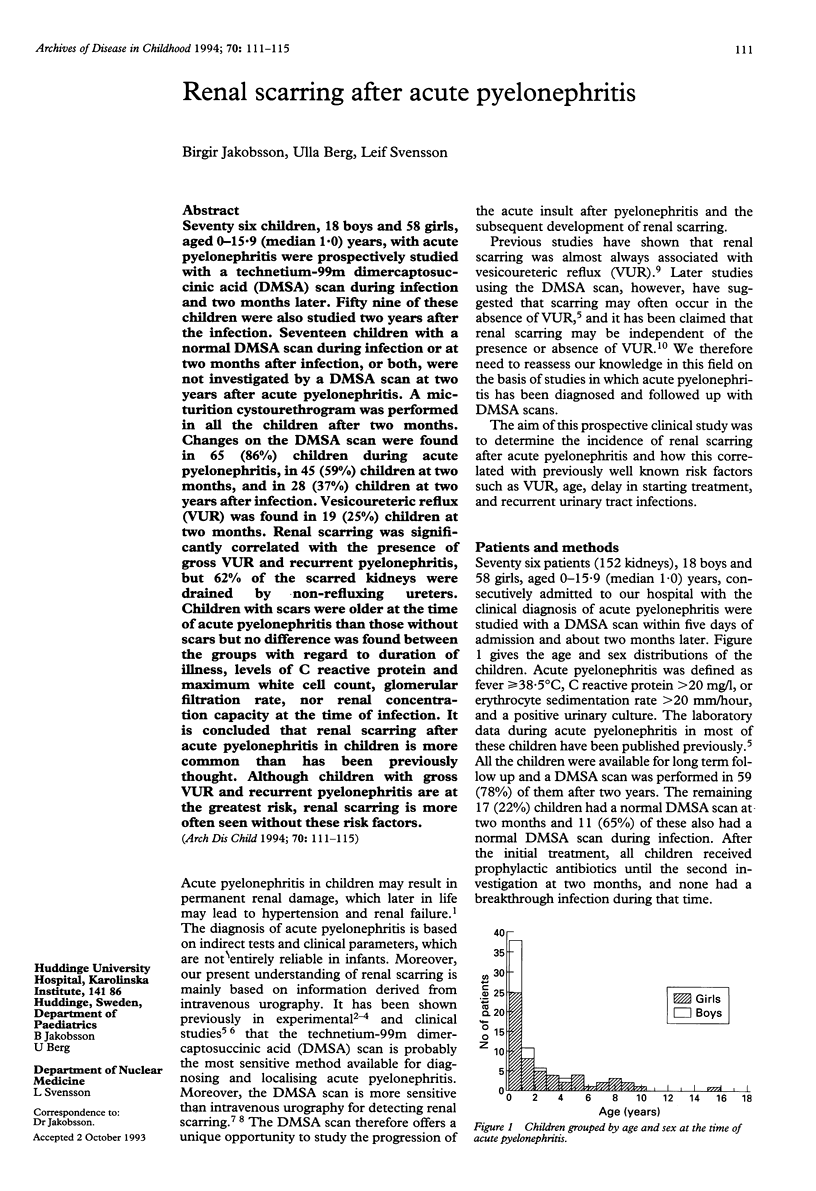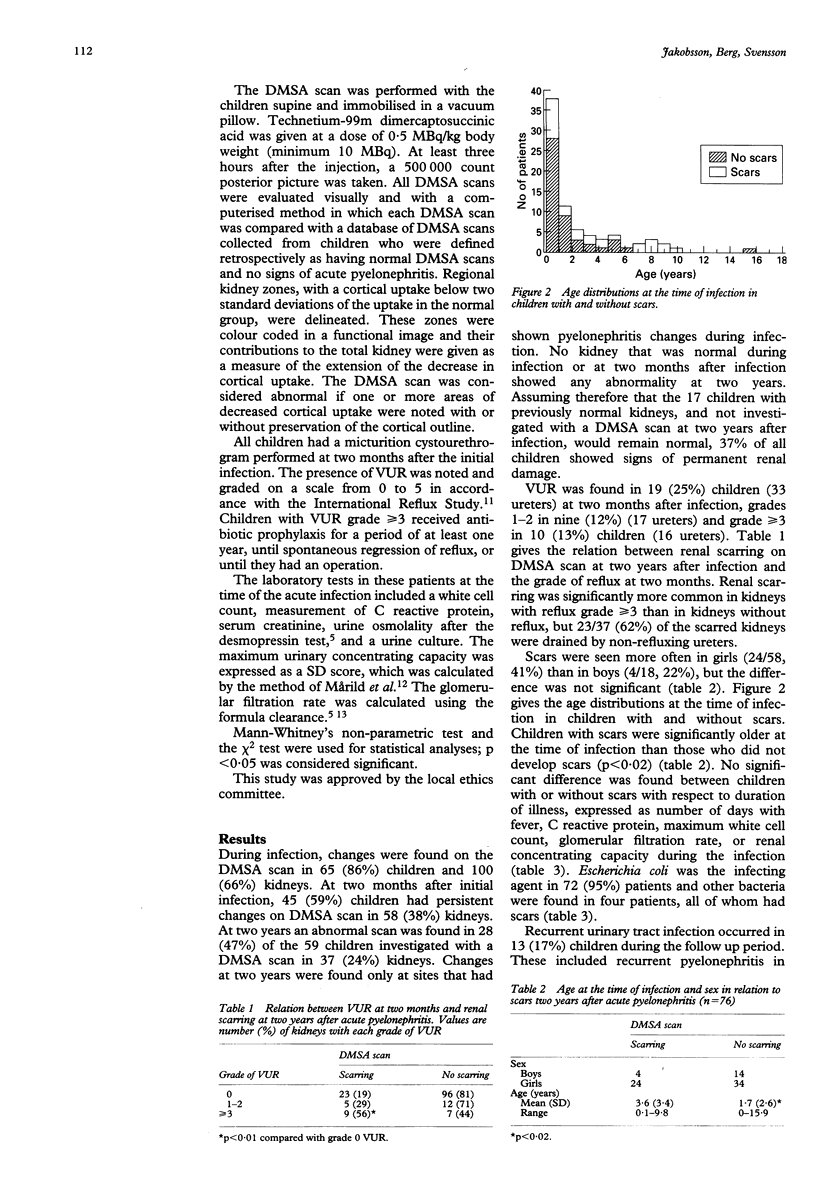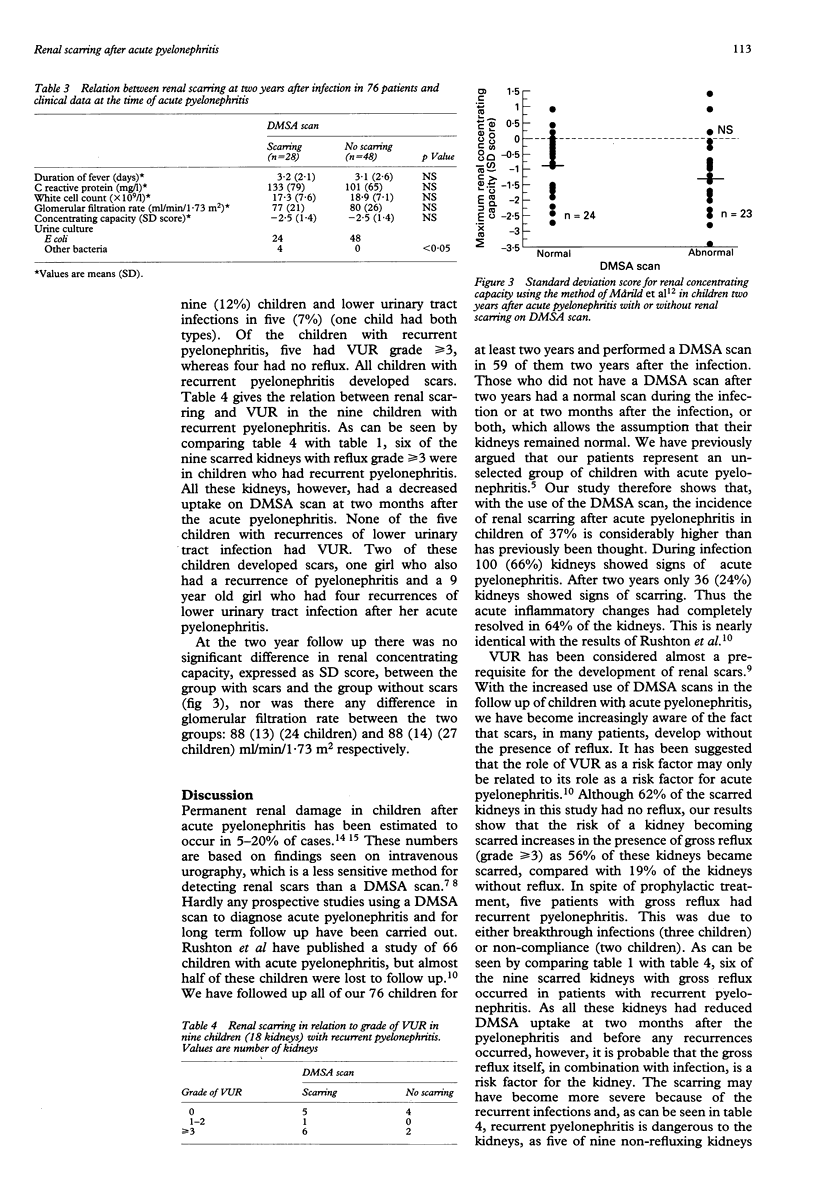Abstract
Seventy six children, 18 boys and 58 girls, aged 0-15.9 (median 1.0) years, with acute pyelonephritis were prospectively studied with a technetium-99m dimercaptosuccinic acid (DMSA) scan during infection and two months later. Fifty nine of these children were also studied two years after the infection. Seventeen children with a normal DMSA scan during infection or at two months after infection, or both, were not investigated by a DMSA scan at two years after acute pyelonephritis. A micturition cystourethrogram was performed in all the children after two months. Changes on the DMSA scan were found in 65 (86%) children during acute pyelonephritis, in 45 (59%) children at two months, and in 28 (37%) children at two years after infection. Vesicoureteric reflux (VUR) was found in 19 (25%) children at two months. Renal scarring was significantly correlated with the presence of gross VUR and recurrent pyelonephritis, but 62% of the scarred kidneys were drained by non-refluxing ureters. Children with scars were older at the time of acute pyelonephritis than those without scars but no difference was found between the groups with regard to duration of illness, levels of C reactive protein and maximum white cell count, glomerular filtration rate, nor renal concentration capacity at the time of infection. It is concluded that renal scarring after acute pyelonephritis in children is more common than has been previously thought. Although children with gross VUR and recurrent pyelonephritis are at the greatest risk, renal scarring is more often seen without these risk factors.
Full text
PDF




Selected References
These references are in PubMed. This may not be the complete list of references from this article.
- Berg U. B., Johansson S. B. Age as a main determinant of renal functional damage in urinary tract infection. Arch Dis Child. 1983 Dec;58(12):963–969. doi: 10.1136/adc.58.12.963. [DOI] [PMC free article] [PubMed] [Google Scholar]
- Berg U. B. Long-term followup of renal morphology and function in children with recurrent pyelonephritis. J Urol. 1992 Nov;148(5 Pt 2):1715–1720. doi: 10.1016/s0022-5347(17)37012-x. [DOI] [PubMed] [Google Scholar]
- Berg U. B. Renal dysfunction in recurrent urinary tract infections in childhood. Pediatr Nephrol. 1989 Jan;3(1):9–15. doi: 10.1007/BF00859616. [DOI] [PubMed] [Google Scholar]
- Bille J., Glauser M. P. Protection against chronic pyelonephritis in rats by suppression of acute suppuration: effect of colchicine and neutropenia. J Infect Dis. 1982 Aug;146(2):220–226. doi: 10.1093/infdis/146.2.220. [DOI] [PubMed] [Google Scholar]
- Emmerson B. T., Row P. G. Editorial: An evaluation of the pathogenesis of gouty kidney. Kidney Int. 1975 Aug;8(2):65–71. doi: 10.1038/ki.1975.81. [DOI] [PubMed] [Google Scholar]
- Glauser M. P., Meylan P., Bille J. The inflammatory response and tissue damage. The example of renal scars following acute renal infection. Pediatr Nephrol. 1987 Oct;1(4):615–622. doi: 10.1007/BF00853599. [DOI] [PubMed] [Google Scholar]
- Goldraich N. P., Ramos O. L., Goldraich I. H. Urography versus DMSA scan in children with vesicoureteric reflux. Pediatr Nephrol. 1989 Jan;3(1):1–5. doi: 10.1007/BF00859614. [DOI] [PubMed] [Google Scholar]
- Jacobson S. H., Eklöf O., Lins L. E., Wikstad I., Winberg J. Long-term prognosis of post-infectious renal scarring in relation to radiological findings in childhood--a 27-year follow-up. Pediatr Nephrol. 1992 Jan;6(1):19–24. doi: 10.1007/BF00856822. [DOI] [PubMed] [Google Scholar]
- Jakobsson B., Nolstedt L., Svensson L., Söderlundh S., Berg U. 99mTechnetium-dimercaptosuccinic acid scan in the diagnosis of acute pyelonephritis in children: relation to clinical and radiological findings. Pediatr Nephrol. 1992 Jul;6(4):328–334. doi: 10.1007/BF00869725. [DOI] [PubMed] [Google Scholar]
- Jakobsson B., Söderlundh S., Berg U. Diagnostic significance of 99mTc-dimercaptosuccinic acid (DMSA) scintigraphy in urinary tract infection. Arch Dis Child. 1992 Nov;67(11):1338–1342. doi: 10.1136/adc.67.11.1338. [DOI] [PMC free article] [PubMed] [Google Scholar]
- Jodal U., Lindberg U., Lincoln K. Level diagnosis of symptomatic urinary tract infections in childhood. Acta Paediatr Scand. 1975 Mar;64(2):201–208. doi: 10.1111/j.1651-2227.1975.tb03822.x. [DOI] [PubMed] [Google Scholar]
- Majd M., Rushton H. G., Jantausch B., Wiedermann B. L. Relationship among vesicoureteral reflux, P-fimbriated Escherichia coli, and acute pyelonephritis in children with febrile urinary tract infection. J Pediatr. 1991 Oct;119(4):578–585. doi: 10.1016/s0022-3476(05)82407-2. [DOI] [PubMed] [Google Scholar]
- Majd M., Rushton H. G. Renal cortical scintigraphy in the diagnosis of acute pyelonephritis. Semin Nucl Med. 1992 Apr;22(2):98–111. doi: 10.1016/s0001-2998(05)80085-6. [DOI] [PubMed] [Google Scholar]
- Miller T., Phillips S. Pyelonephritis: the relationship between infection, renal scarring, and antimicrobial therapy. Kidney Int. 1981 May;19(5):654–662. doi: 10.1038/ki.1981.65. [DOI] [PubMed] [Google Scholar]
- Mårild S., Jodal U., Jonasson G., Mangelus L., Odén A., Persson N. G. Reference values for renal concentrating capacity in children by the desmopressin test. Pediatr Nephrol. 1992 May;6(3):254–257. doi: 10.1007/BF00878361. [DOI] [PubMed] [Google Scholar]
- Parkhouse H. F., Godley M. L., Cooper J., Risdon R. A., Ransley P. G. Renal imaging with 99Tcm-labelled DMSA in the detection of acute pyelonephritis: an experimental study in the pig. Nucl Med Commun. 1989 Jan;10(1):63–70. doi: 10.1097/00006231-198901000-00010. [DOI] [PubMed] [Google Scholar]
- Pylkkänen J., Vilska J., Koskimies O. The value of level diagnosis of childhood urinary tract infection in predicting renal injury. Acta Paediatr Scand. 1981 Nov;70(6):879–883. doi: 10.1111/j.1651-2227.1981.tb06244.x. [DOI] [PubMed] [Google Scholar]
- Rushton H. G., Majd M., Chandra R., Yim D. Evaluation of 99mtechnetium-dimercapto-succinic acid renal scans in experimental acute pyelonephritis in piglets. J Urol. 1988 Nov;140(5 Pt 2):1169–1174. doi: 10.1016/s0022-5347(17)41992-6. [DOI] [PubMed] [Google Scholar]
- Rushton H. G., Majd M. Dimercaptosuccinic acid renal scintigraphy for the evaluation of pyelonephritis and scarring: a review of experimental and clinical studies. J Urol. 1992 Nov;148(5 Pt 2):1726–1732. doi: 10.1016/s0022-5347(17)37014-3. [DOI] [PubMed] [Google Scholar]
- Rushton H. G., Majd M., Jantausch B., Wiedermann B. L., Belman A. B. Renal scarring following reflux and nonreflux pyelonephritis in children: evaluation with 99mtechnetium-dimercaptosuccinic acid scintigraphy. J Urol. 1992 May;147(5):1327–1332. doi: 10.1016/s0022-5347(17)37555-9. [DOI] [PubMed] [Google Scholar]
- Schwartz G. J., Brion L. P., Spitzer A. The use of plasma creatinine concentration for estimating glomerular filtration rate in infants, children, and adolescents. Pediatr Clin North Am. 1987 Jun;34(3):571–590. doi: 10.1016/s0031-3955(16)36251-4. [DOI] [PubMed] [Google Scholar]
- Smellie J. M., Ransley P. G., Normand I. C., Prescod N., Edwards D. Development of new renal scars: a collaborative study. Br Med J (Clin Res Ed) 1985 Jun 29;290(6486):1957–1960. doi: 10.1136/bmj.290.6486.1957. [DOI] [PMC free article] [PubMed] [Google Scholar]
- Svanborg Edén C., Hausson S., Jodal U., Lidin-Janson G., Lincoln K., Linder H., Lomberg H., de Man P., Mårild S., Martinell J. Host-parasite interaction in the urinary tract. J Infect Dis. 1988 Mar;157(3):421–426. doi: 10.1093/infdis/157.3.421. [DOI] [PubMed] [Google Scholar]
- Verber I. G., Strudley M. R., Meller S. T. 99mTc dimercaptosuccinic acid (DMSA) scan as first investigation of urinary tract infection. Arch Dis Child. 1988 Nov;63(11):1320–1325. doi: 10.1136/adc.63.11.1320. [DOI] [PMC free article] [PubMed] [Google Scholar]
- Whitear P., Shaw P., Gordon I. Comparison of 99Tcm dimercaptosuccinic acid scans and intravenous urography in children. Br J Radiol. 1990 Jun;63(750):438–443. doi: 10.1259/0007-1285-63-750-438. [DOI] [PubMed] [Google Scholar]
- Wikstad I., Hannerz L., Karlsson A., Eklöf A. C., Olling S., Aperia A. 99mTechnetium dimercaptosuccinic acid scintigraphy in the diagnosis of acute pyelonephritis in rats. Pediatr Nephrol. 1990 Jul;4(4):331–334. doi: 10.1007/BF00862511. [DOI] [PubMed] [Google Scholar]
- Winberg J., Bollgren I., Källenius G., Möllby R., Svenson S. B. Clinical pyelonephritis and focal renal scarring. A selected review of pathogenesis, prevention, and prognosis. Pediatr Clin North Am. 1982 Aug;29(4):801–814. doi: 10.1016/s0031-3955(16)34213-4. [DOI] [PubMed] [Google Scholar]


